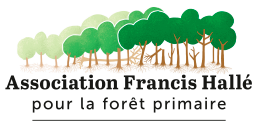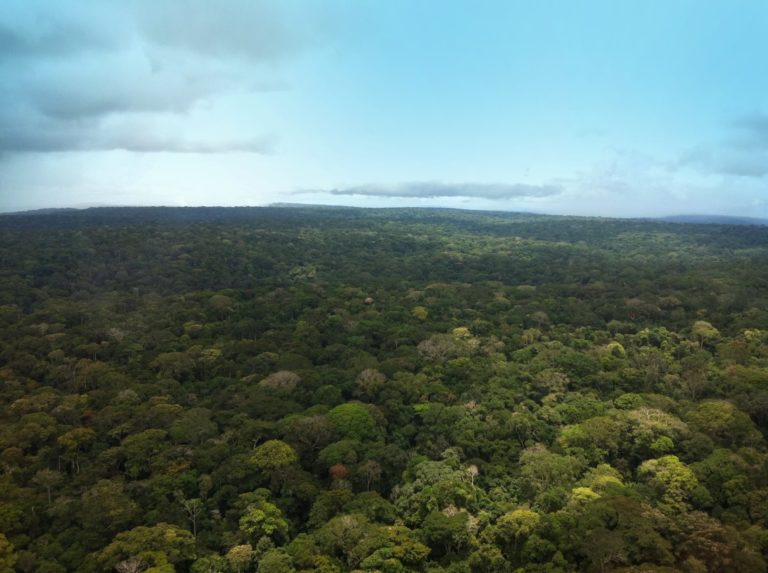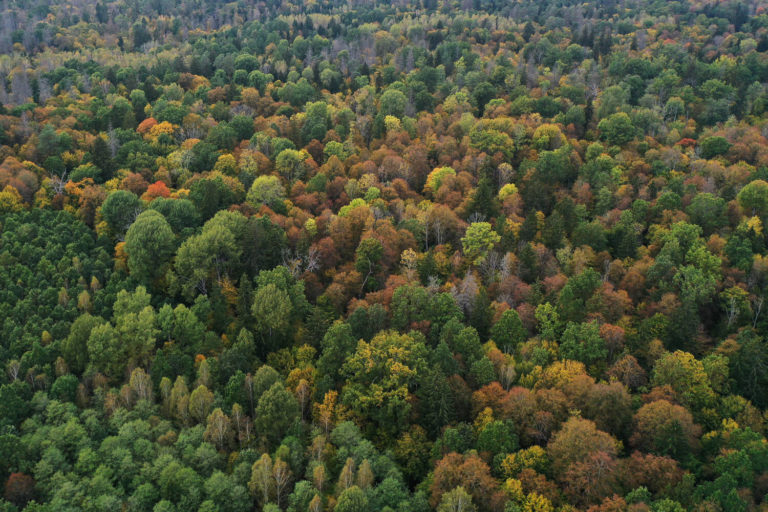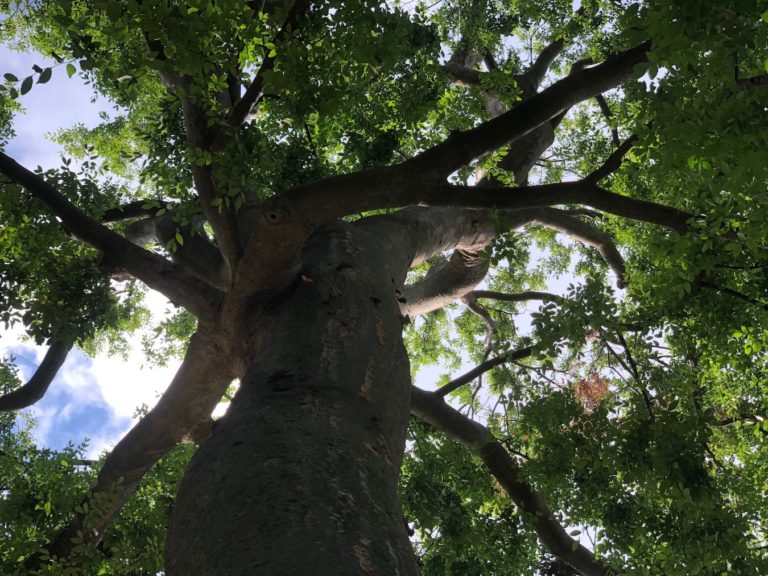This text is taken from an interview with Francis Hallé, conducted by Éric Fabre in the context of the 2020 COVID crisis.
The Covid19 global pandemic and the colossal health, economic, social and cultural crisis that it has engendered for human society has cruelly revealed the dramatic consequences of the degradation of biodiversity. From the point of view of a botanist and specialist in forests – especially tropical forests – how does all this manifest itself? What is the relationship between human health and biodiversity?
Biodiversity, quite simply, keeps us alive. Take everything that comes from biological diversity out of our daily diet; do you know what would be left for us to eat and drink? Salt water, nothing more!
There is also a philosophical reason for our attachment to biodiversity: we are part of it; the human species is the product of biological evolution, just like any other living species.
So what role should forests play in these biodiversity-related issues?
A huge one. You can be in any temperate, tropical or very high latitude region, but whatever the region, if you have a forest, you will have maximum biological diversity. All other types of vegetation are less rich. And we can specify that this wealth of species, linked to the forest, is both above and below ground. No other environment can match this richness.
The last COP 25 was particularly disappointing. Do you think that forests get the attention they deserve in world affairs today?
Definitely not! Very little attention is given to forests. There isn’t a COP dedicated to forests. Yet if we care about biodiversity, forests should be at the forefront.
So if you had to sketch out possible actions, a Global Forest Plan, what would you put in as the main lines of thought and action?
At this critical point in time, I would argue the need for a truly global New Deal for forests with two main points:
- First, all questions related to forests should no longer be the responsibility of the FAO (Food and Agriculture Organization), which sees them from a far too narrowly managerial and quasi-industrial viewpoint and is therefore not at all up to the task at hand. We need to create a new World Forest Agency that is also under UN authority and that will treat the ecosystem for what it is, in all its unique characteristics. We should let the FAO manage tree plantations, which is another matter, a respectable one, but by no means that of forests.
- Next, we should define (World Conventions, COP, etc… There are many technical and human resources available to this end) the main priorities of a shared world policy on forests and all their aspects, and then to set up the appropriate structure to enforce it in today’s world.
Isn’t it about time? Since the forests are literally burning?
Yes, one of the priorities should be fire protection. It’s easy to say, but it’s so simple to start a fire. Any idiot, criminal or not, can do it. I have contacts in Australia, and it’s absolute horror; these aren’t big fires, they’re mega-fires, a notch above. You can’t do anything about mega-fires, they create a column of flame that chokes and a ball that goes off and falls 10 km away. So no matter how much manpower and equipment you put in, there’s nothing you can do. The Australians are off to a very bad start. I’m very worried about that country. I wonder if this is a forerunner of events on a global scale, if we don’t manage to limit the rise in temperatures.
Beyond these new means, there are huge security and protection issues at stake for these existing forests, what do you think should be done?
I think our knowledge about forests is still too rudimentary.
We don’t even know the forests of Europe or those in temperate regions that well. We need to put more effort into advancing research.
More generally though, shouldn’t we turn our focus back to the tree itself? So that we can see the forest through the trees…?
Yes, you’re right, it all starts at the tree level. There isn’t enough research being done on trees. And I’m not saying that because I study trees. I’m not being parochial… There just aren’t enough of us interested in tree biology.
And yet it seems like we’ve been talking about trees for a while now, scientists, authors, storytellers…
It hasn’t been that long. When I was a young researcher no one was talking about taking care of trees. There was a simple reason for that: the Water and Forests Administration was in charge of tree research. So universities were told to leave the matter alone, to forget about it. This has only recently changed, so people say, “you have to admit there is a flood of books,” and it’s true, but this only began after research started being carried out independently of the Water and Forests Administration. Because even if they deny it, their research was always aimed at producing the maximum amount of wood in the shortest possible amount of time.
In the context of this global discussion, the focus on trees and the different relationships people have with them, what is the point of our project to “restore” a primary forest in Western Europe?
We think our forests are beautiful, but if they were replaced by primary forests we would see what a truly beautiful forest looks like. They are infinitely more beautiful than any of our forests, even the Forest of Tronçais. What we consider to be the best in terms of forests is very little, from an aesthetic point of view, compared to a primary forest.
And beyond its beauty and its size?
In my view, it’s fundamentally philosophical. Are we capable of coexisting with a primary forest? So far, in Western Europe, we haven’t proven that we are because we haven’t understood the value of a primary forest, we’ve only understood that we can make a lot of money from it. I’ve often felt that our project was a test of human nature.
A test? What do you mean?
If we manage to create this primary forest (over a very long period of time and over a large area), it will mean that we as humans are able to think logically and act consistently, with a sense of transmission from generation to generation and respect for what has already been done. If we aren’t able to do this, then it will mean that we are bad.
Is this one of the challenges in the fight against climate change?
Yes, of course, but even 70,000 hectares won’t be enough. That would definitely be going in the right direction but it’s only a drop of water in a bucket. Yes, fighting climate change means storing carbon and emitting oxygen and a forest is very good at doing that. How much oxygen is released is a bit debatable because when a forest gets older it releases less, but carbon storage is function of the forest’s lifespan. It’s true that they are linked to climate change, but not on the same scale.
The important thing here is that this forest will revive the biodiversity that we so dearly need.
So, why so big and why so long?
The vast size is linked to the presence of large fauna, since a primary forest contains both trees and animals. The long timeframe is not a choice, it is the amount of time required for the restoration of a primary forest in temperate latitudes, and no one can accelerate this process.
Rebuilding nature? That’s a highly debated topic…
Terrasson, a great French naturalist, used to say, “You love nature? Well then leave it alone!”
Régis Debray, who prefers the term “milieu” to “environment” and who is well-aware of the issues of climate change, nevertheless criticizes what he calls the “idolatry of nature,” claiming that “man represents civilization while nature is the survival of the fittest (…)” and “we never thought that we would one day have to bow down before trees.”
There comes a time when we have to change our habits.
It’s not “idolatry.” That’s a negative term. It’s like “putting nature in a glass case” or “protecting at any cost”… Some of these terms get on my nerves. I’ll gladly bow down to trees because we wouldn’t be around without them. They enable us to live – not the small plants – the trees. I have no problem bowing down to trees. I mean, I’m not going to hug them or kiss them, but I know that they guarantee the quality of the “milieu” – to use the term – and that they are vital to us.
Is nature without human beings conceivable?
Of course it is! The human species is 300,000 years old. What was there before? 380 million years of forests where nature flourished without us. Perhaps nature wouldn’t be entirely complete without the species that you and I are members of. That would be missing. But it is totally conceivable for nature to exist without man. I am lucky enough to have witnessed this in several tropical countries.
Aren’t humans still living in these forests, though?
Yes, that’s true, there are people living in forests, but you can’t say that the forest needs them. I don’t hold it against them at all: they do no harm, there are very few and they’ve never had any industrial or commercial ambition. They’re just worried about their own survival. That doesn’t destroy the forest.
At the end of the day, nature can get along just fine without us. We have to see the bigger, long term picture. Humans arrived last, they’ve been around for a very short period of time and have already destroyed half of the forests on the planet. This kind of human behavior obviously isn’t sustainable.
If you could make a wish in 2020, which has been such a dramatic year, what would it be?
That’s easy. My wish would be for our leaders, beyond electoral reasons, to be deeply convinced of the importance of this global ecology. It’s a matter of survival that current events have unfortunately just made more obvious. But our leaders aren’t there yet.
When you say survival, are you saying we’ll die if forests disappear?
Yes, without a doubt, from a lack of oxygen and a lack of carbon fixation. We’ll die, no question about it. We’ll no longer have the gas that we need and we’ll be invaded by a different gas that may not be toxic but serves no purpose in allowing us to breathe.
It’s not enough to state the truth for people to grasp it. How can we convince people that forests are vital?
We have to invest in children, schools and preschools, because that’s where it all happens. The answer to this question is: through reflexes acquired in childhood. That’s when you learn to respect forests. To respect nature in general.
Through field trips?
Yes. The children are in awe, they fall in love. And there you go, you did it. I’m under the impression that lower schools are doing less and less in that regard – some teachers told me that. A few years ago, they still used to have plants and animals in classrooms, but now that’s all over. They’ll save money on anything they can nowadays… It’s ridiculous. The solution for ecological awareness is to educate children at a very young age.
If a lot of money could be invested into the world’s forests, if you had all the resources you wanted, what would you do?
I would put two thirds into teaching children, the youth, and the remaining third into research.
There’s a lot of talk about forests these days but there are also initiatives being developed: freely evolving reserves, tree planting, etc… How does the project for restoring a great primary forest fit in with all these initiatives?
We won’t be much better off until we stop confusing tree plantations with forests. Forests are very resilient but they don’t generate profit for industrialists, whereas tree plantations are much more financially profitable. So the confusion serves the timber industry. Plantations lack terribly in resilience, they are vulnerable to pests, fires and strong winds. What strikes me most is their sensitivity to fire. Mega-fires happen in plantations, not in forests.
So the big difference…
The biggest difference with forests is biodiversity.
Obviously, planting is better than destroying. And there’s a whole movement around that, I’m not arguing against it. We want to improve things together. Anything that favors free evolution is very positive.
But when you plant, especially in view of exploitation, you don’t create a forest, you create a plantation of trees. One thing is obvious on our planet: there are fewer and fewer forests and more and more plantations. We therefore have to disprove those who claim that they are the same thing.
So we leave nature alone and…we wait?
Yes, we let nature and the forests restore themselves, and that’s what our project is all about, from the very start and for the very long term. I have nothing against plantations; we need wood and we’re not about to do without it, so we have to plant trees for that specific purpose. That doesn’t shock me. But to call these “tree plantations” “forests” is in my opinion a very, very dangerous misinterpretation.
If we plant trees, they will all be the same age. Logging in plantations takes place before the trees are mature. If they have the right diameter for harvesting, they are cut down and the same species is replanted. There is very little biodiversity around a single tree species. With the current techniques, everything is collected. There is never any leftover wood. Once the wood has been collected, the same species is replanted. Do this four or five times and the soil can’t take it anymore.
Free evolution is different.The different tree species don’t draw the same resources from the soil, so it balances out: we let the trees rot on the ground and that’s where the biodiversity comes from. We need trees that die standing and others that decompose on the ground.
All this undoubtedly takes a very long time, but nature develops in the long term and that is something we must become reacquainted with. We have destroyed faster than we have built. Trees, unfortunately, know this all too well…
Interview by Eric Fabre, May 2020



